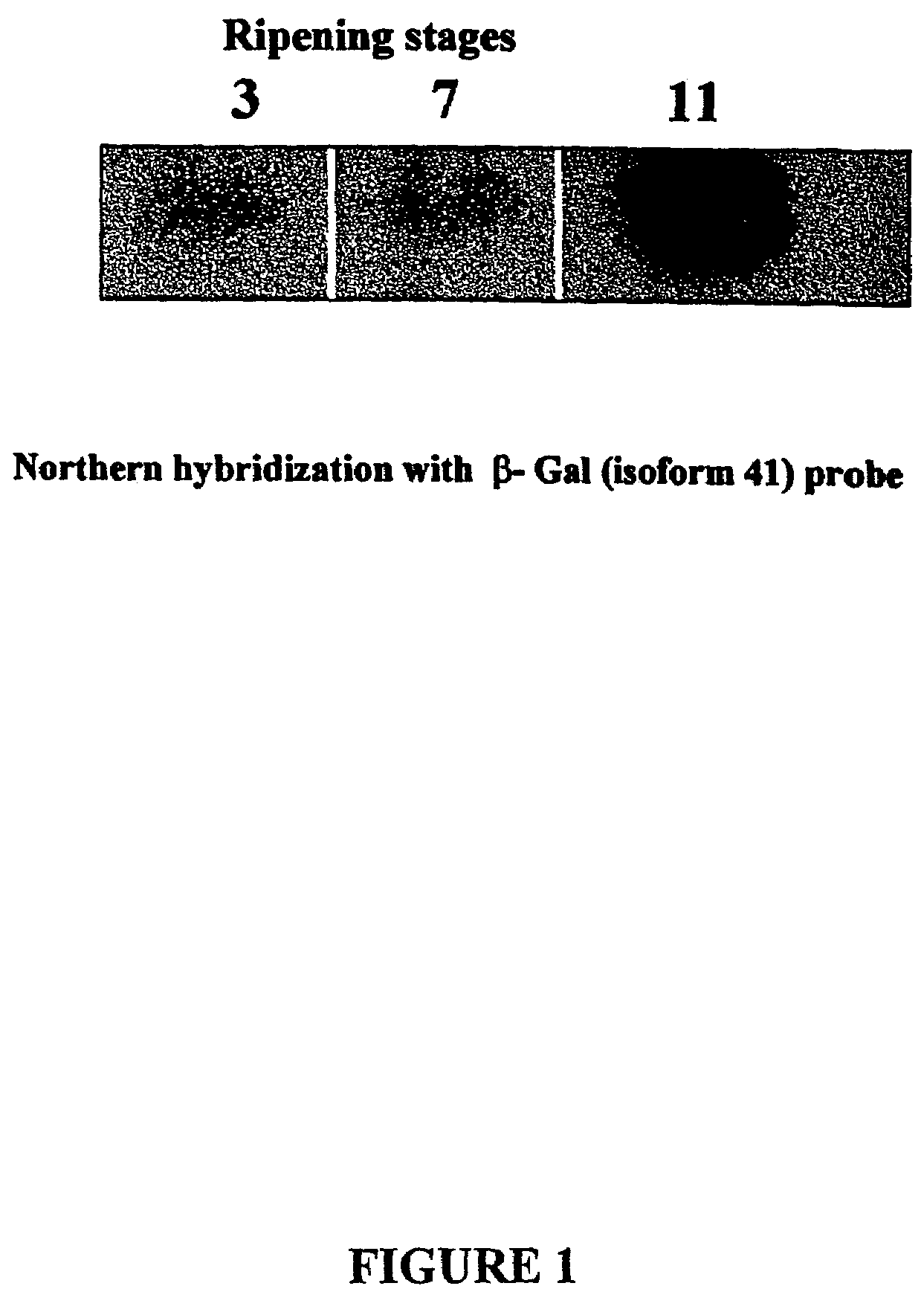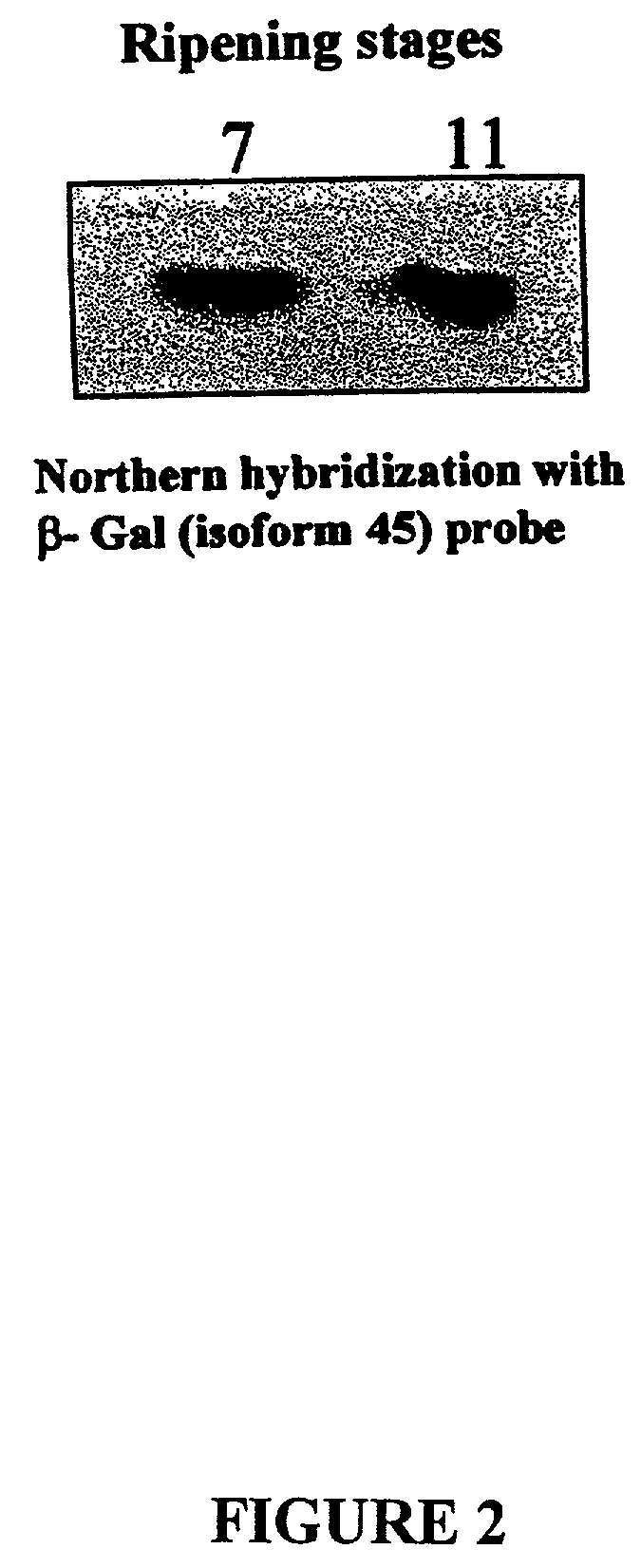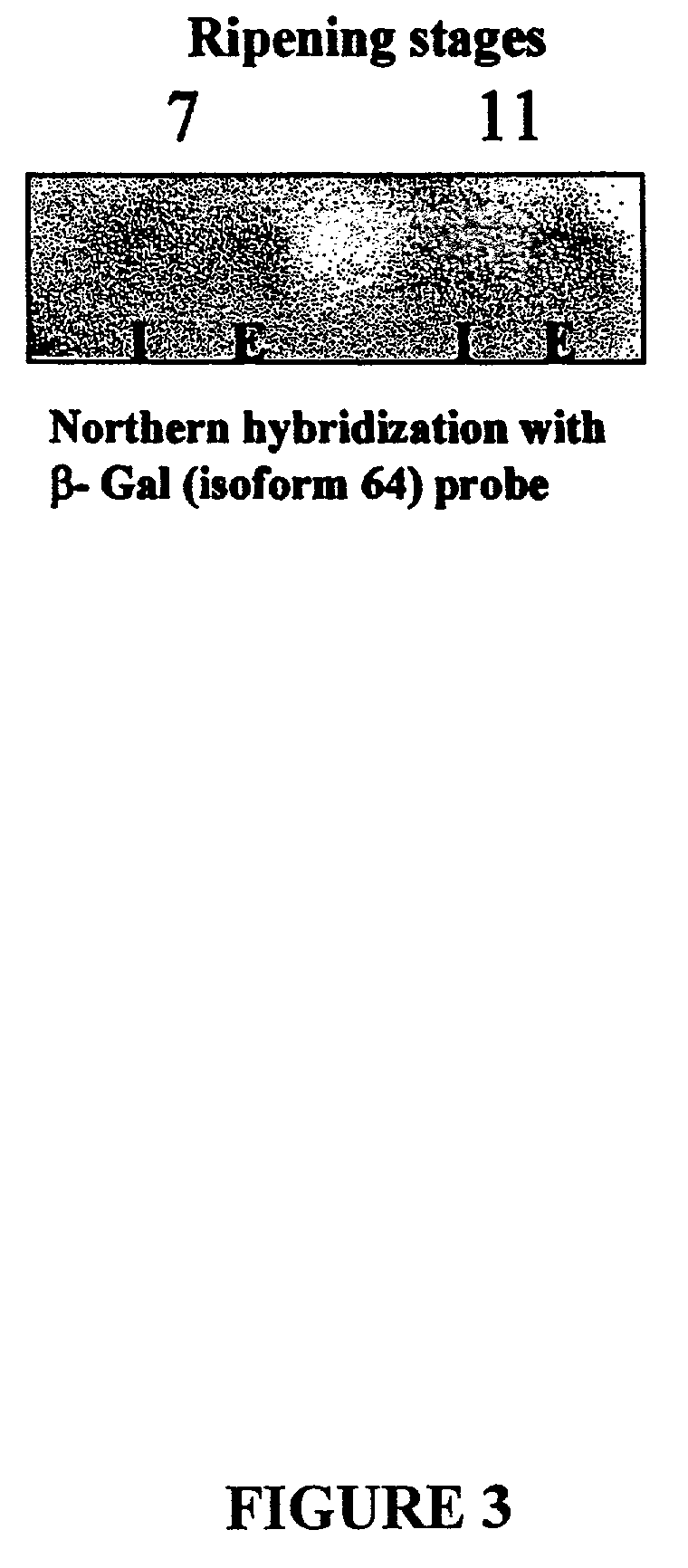Isolated nucleic acid molecules relating to papaya fruit ripening
a technology papaya fruit, which is applied in the field of nucleic acid molecules involved in papaya fruit ripening, can solve the problems of fruit damage, fruit is fragile, and cannot develop the optimal fruit flavor and color, and achieve the effect of preventing the ripening of papaya frui
- Summary
- Abstract
- Description
- Claims
- Application Information
AI Technical Summary
Benefits of technology
Problems solved by technology
Method used
Image
Examples
example 1
Enzyme Extraction and Determination of Activity Relative to Fruit Ripening
[0080]After harvest, mature green papayas from Guinea-Bissau were brought to the laboratory and allowed to ripen at 25° C. At different ripening stages (1, 3, 5, 7, 9, and 11 days), the fruit was sampled, cut transversally in two parts, and seeds were removed. Inner mesocarp was separated from the outer mesocarp, and each tissue was separately homogenized in liquid nitrogen using a Waring blender. The homogenized pulp was instantly frozen at −80° C.
[0081]PME was extracted, and PME activity was assayed as in Fayyaz et al., “Pectinesterase Extraction From Papaya,”Food Chem. 47: 183–185 (1993), which is hereby incorporated by reference in its entirety.
[0082]Extraction of β-Galactosidases was as described in Ranwala et al., “The Role of β-Galactosidases in the Modification of Cell Wall Components During Muskmelon Fruit Ripening,”Plant Physiol. 100:1318–1325 (1992), which is hereby incorporated by reference in its ...
example 2
RNA Isolation
[0091]RNA was obtained from papaya at various stages of maturation using the following method. Papaya tissues were ground to a fine powder in liquid nitrogen in a Waring blender. Using a metal spatula chilled in liquid nitrogen, the powder was quickly transferred to tubes containing a mixture (1:1) of extraction buffer (200 mM-sodium acetate, 10 mM EDTA and 1% SDS): equilibrated phenol (pH 4.3), preheated at 65° C. for 5 min. After homogenization by vortexing for 5 min, 0.5× volume of chloroform: isoamyl alcohol (24:1) was added. After vortexing for 5 min, the homogenate was centrifuged at 10,000 rpm for 10 min. at 4° C. Using a sterile glass pipette, the upper aqueous phase was transferred to polypropylene tubes and equal volume of chloroform isoamyl alcohol (24:1) was added. Vortexing for 5 min and centrifugation for 10 min at 10,000 rpm at 4° C. were repeated. Using a sterile glass pipette, the upper aqueous phase was again transferred to polypropylene tubes and equa...
example 3
cDNA Library Construction and Screening Method
[0093]A cDNA library was constructed using 5 μg of poly(A+) RNA prepared from mature papaya fruit using a ZAPA Express cDNA synthesis kit (Stratagene, La Jolla, Calif.). cDNA was cloned into the ZAPA-Lambda vector (Stratagene, La Jolla, Calif.) and packaged in Gigapack Gold III (Stratagene, La Jolla, Calif.). The primary library was amplified according to the manufacturer's protocols. Duplicate plaque lifts of 1×106 amplified recombinants were hybridized with gel purified, radiolabeled inserts from CPSPE1, CPβGal., or PG RT-PCR or RACE 5′ / 3′ cDNA clones (prepared as described below), using the Stratagene protocol. Hybridized filters were washed twice in 2×SSC and 0.1% (w / v) SDS at 65° C. and twice in 0.1×SSC and 0.1% (w / v) SDS at 65° C. and exposed to film at −80° C. Positive plaques were carried through two additional rounds of screening for purification and then in vivo excised to release the phagemid DNA. Positive cDNA clones correspo...
PUM
| Property | Measurement | Unit |
|---|---|---|
| Antisense | aaaaa | aaaaa |
Abstract
Description
Claims
Application Information
 Login to View More
Login to View More - R&D
- Intellectual Property
- Life Sciences
- Materials
- Tech Scout
- Unparalleled Data Quality
- Higher Quality Content
- 60% Fewer Hallucinations
Browse by: Latest US Patents, China's latest patents, Technical Efficacy Thesaurus, Application Domain, Technology Topic, Popular Technical Reports.
© 2025 PatSnap. All rights reserved.Legal|Privacy policy|Modern Slavery Act Transparency Statement|Sitemap|About US| Contact US: help@patsnap.com



